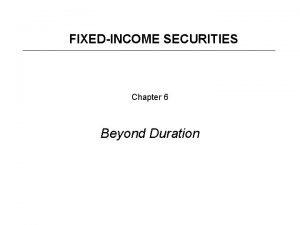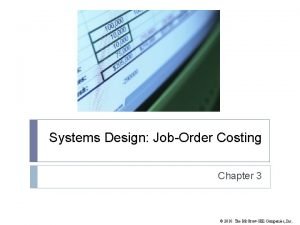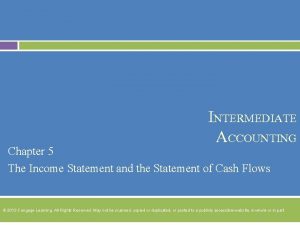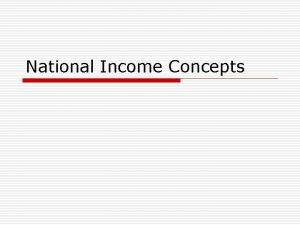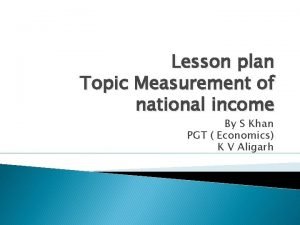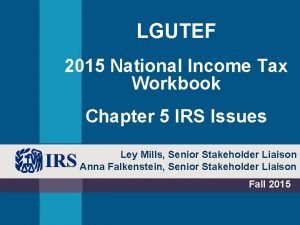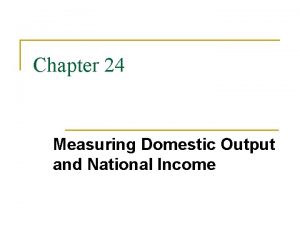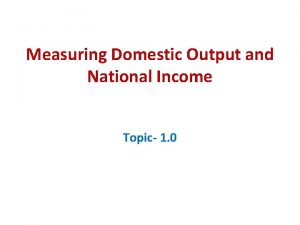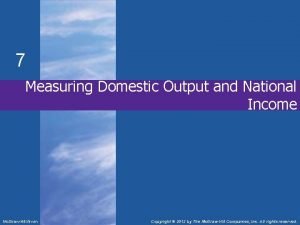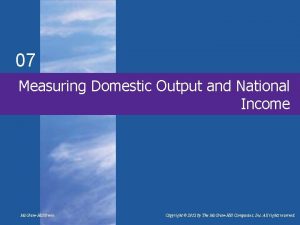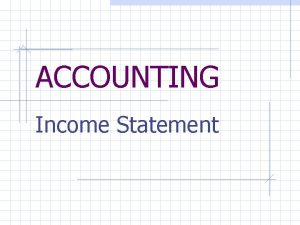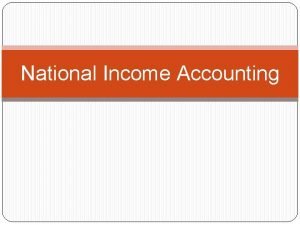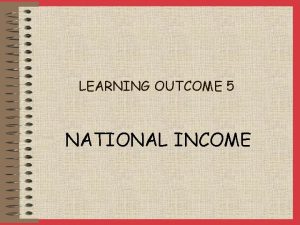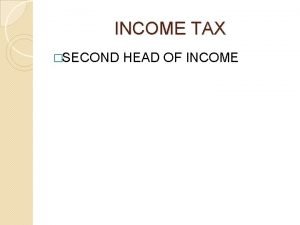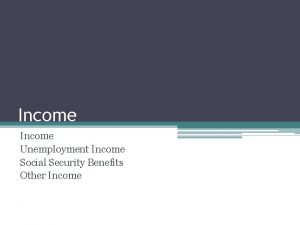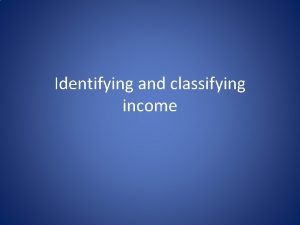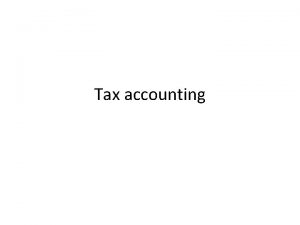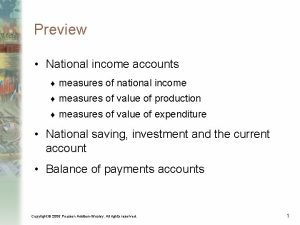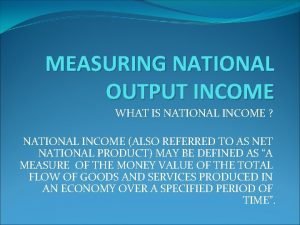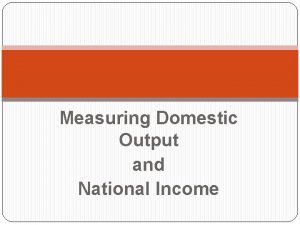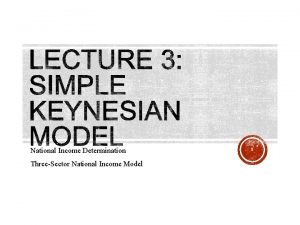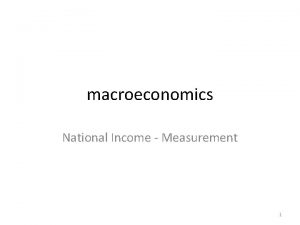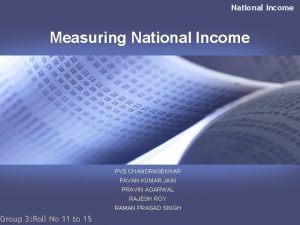National Income Accounting 1 Introduction National income accounting




























- Slides: 28

National Income Accounting 1

Introduction National income accounting provides us with ex-post data about national income, it cannot explain the level and determinants of national income. The following identities are true for any level of income. In order to explain and predict the level of national income, models are constructed. 2

Factor Market Product Market Factor services Goods & services Real Flow Factor Owners Consumers Firm Money Flow Factor Income Cost Revenue Expenditure The flow of economic activities in a 2 -sector economy 3

GNP v. s. GDP Gross National Product (GNP) The total value at market prices of final goods and services produced by the citizens in an economy in a specified period. Gross Domestic Product (GDP) The total value at market prices of final goods and services produced within the domestic boundary of a territory in a specified period 4

GNP & GDP Flow concept Resale of existing houses Sale of used cars / existing shares Commission / Brokers’ fee Imputed rents of owner-occupied dwellings Capital gain is not income (Irving Fisher) Only the interest earned from the capital gain is considered as income 5

Real GNP & Nominal GNP & Per capita GNP Real GNP=(Nominal GNP/GNP Deflator)*100 Per capita GNP = GNP / Population size 6

Measurement of National Income Approach NNP at factor cost OR National Income Output Approach GDP at factor cost Expenditure Approach GDP at market Prices 7

Expenditure Approach GDP at market price Indirect sales tax + Indirect subsidies GDP at factor cost + Factor Income- Factor Income paid Net income from abroad GNP at factor cost Depreciation NNP at factor cost C+I+G+X-M Output Approach Income Approach W+I+R+P 8

NNP at factor cost Retained profits Social insurance / Mandatory Provident Fund Direct business Tax + Transfer payments Personal income Direct personal taxes Disposable personal income - Consumption = Saving 9

Income Approach W+I+R+P = NNP at factor cost Profits are stated net of depreciation / capital consumption allowances If the figures exclude net income from abroad, NDP at factor cost can be obtained. NDP at factor cost + Net income from abroad = 10

Output Approach The total value of the final goods and services produced by the primary / secondary / tertiary industries In order to avoid double counting, the value-added method is adopted to exclude intermediate goods. GDP at factor cost + Indirect Taxes – Indirect Subsidies = Distinguish between Indirect / Direct / Business / Personal Taxes 11

Expenditure Approach People spend their income. Thus, the total expenditure on final goods and services must be equal to the total value of final goods and services produced domestically. Any output that is not sold to consumers is bought by producers in the form of unintended inventory investment. C+I+G+(X-M) = Aggregate / Total expenditure 12

Expenditure Approach Private Consumption Expenditure (C) Gross Investment Expenditure (I) Firms : plant (in progress) / unused raw materials Households : residential building Inventory investment : intended unintended (reduce information cost) - gross domestic fixed capital formation* - change in stocks & work in progress *gross national fixed capital formation GNP Government Expenditure (G) at market prices roads/education/medical & health services/law & order/public works/… salary to civil servants, NOT transfer payments at the cost to taxpayers, NOT at market prices Net Exports (X-M) the value of imports is included in C, I, G, X Exports include domestic exports & re-exports 13

Items excluded from National Income Accounting Second-hand goods Intermediate goods Non-marketed goods / services Volunteer work / Housework Unreported / Illegal market transactions 14

Merits & Uses of National Income Statistics Reflecting & comparing the standards of living of different countries Per capita real GNP standard of living Providing information to the government and firms for economic planning Reflecting the economic growth of a country % change in real GNP over a period of time 15

Limitations of National Income Statistics Factors that may understate the standard of living / the welfare Exclusion of the value of leisure Same Q produced with fewer working hours higher welfare Exclusion of non-marketed / unreported transactions 16

Limitations of National Income Statistics Factors that may overstate the standard of living / the welfare Undesirable Side-effects of Production Air pollution / traffic congestion /… Understate the real / social costs to society externality /divergence between social costs & private costs 17

When comparing economic performances using national income statistics, Price Level use real GNP eliminate the effect of inflation Size of Population use per capital GNP Income Distribution more even distribution higher welfare Composition of National income more consumption, less national defence higher welfare Exchange Rates expressed in the same currency whether the exchange rates reflects the purchasing power of the 2 currencies 18

Inflation A general and sustained increase in the prices of all goods and services GNP deflator / GDP deflator Consumer Price Index (CPI) Producer Price Index (PPI) When constructing price indices different weighting will be given to different commodities reflecting their relative importance on the consumers’ expenditure A base year is chosen during which the economy experiences no economic crisis 19

Calculating a Price Index Item Expenditure Weight 1991 Prices 1991 Price Relatives 1991 Prices Price 1992 Relatives 1992 Transport 1000 10 15 100 15 Clothing 2000 20 100 100 Housing 3000 30 500 100 650 130 Food 4000 40 200 100 220 110 100 20

Calculating a Price Index (cont’d) Price Index in 1991 =0. 1*100+0. 2*100+0. 3*100+0. 4*100 =100 Price Index in 1992 = = The general price level in 1992 has increased by % Only persistent increase in the price indices implies inflation 21

Consumer Price Indices Only consumer goods are included Persistent increase in the CPI implies an increase in the cost of living unless there is a compensating rise in money income CPI(A), CPI(B), HSCPI are constructed to measure the change in the cost of living of different income groups since they have different consumption patterns. Different weights are assigned to different categories of goods to reflect their relative importance. 22

Uses of the CPI In the following table, the real income is increasing, this implies that the standard of living is also increasing for a typical citizen Year CPI Nominal Real income 1991 90 7650 1992 Base year 1993 100 8820 105 9555 8500 =(7650/90)*100 8820 = 9100 = 23

Limitations of the CPI Only consumer goods are included CANNOT reflect the inflation rate accurately Change in consumption pattern the weights are fixed misleading Change in quality of goods CPI due to better quality overstate inflation Possibility of Substitution overstate the impact of inflation if consumers substitute cheaper goods for dearer goods 24

Implicit GNP Deflator To measure inflation, this is a better indicator as it has a wider coverage of commodities Year GNP deflator Inflation Rate between …. 1990 90 1991 100 1992 121 1991 &1992 [(121 -100)/100]*100% = 21% 25

Unemployment Working Population OR Labour Force Working Population=Employed+Unemployed+Self-employed Un-employment Rate =(Unemployed/Labour Force)*100% Under-employment Rate 26

Method of Analysis Endogenous variable the value of the variable is determined inside the model ( x, y) Exogenous variable the value of the variable is determined by forces outside the model ( m, c) any change is regarded as autonomous 27

C C C Y I C=f(Y) Y C=a+c. Y I=f(Y) I=I*+i. Y I Y Y Y C=a+c’Y C=c*Y 28
 Tax liability definition
Tax liability definition Accounting income vs taxable income
Accounting income vs taxable income Gdp calculation expenditure approach
Gdp calculation expenditure approach Pagkakaiba ng gni at gdp
Pagkakaiba ng gni at gdp Gnp vs gdp
Gnp vs gdp Non operating income
Non operating income Income statement in financial accounting
Income statement in financial accounting Income accounting u of u
Income accounting u of u Fixed income accounting
Fixed income accounting Cost accounting income statement
Cost accounting income statement Chapter 5 intermediate accounting
Chapter 5 intermediate accounting Sfas 109
Sfas 109 Income tax expense
Income tax expense Annual rental value of the letout house is-
Annual rental value of the letout house is- Fixed income securities
Fixed income securities Nnp calculation formula
Nnp calculation formula The national income and product accounts
The national income and product accounts National income lesson plan
National income lesson plan National income formula
National income formula National income tax workbook
National income tax workbook Measuring domestic output and national income
Measuring domestic output and national income Linear algebra
Linear algebra National income data
National income data What is national income
What is national income Measuring domestic output and national income
Measuring domestic output and national income Measuring domestic output and national income
Measuring domestic output and national income Measuring domestic output and national income
Measuring domestic output and national income Financial accounting and accounting standards chapter 1
Financial accounting and accounting standards chapter 1 Advantages of computerized accounting system
Advantages of computerized accounting system








